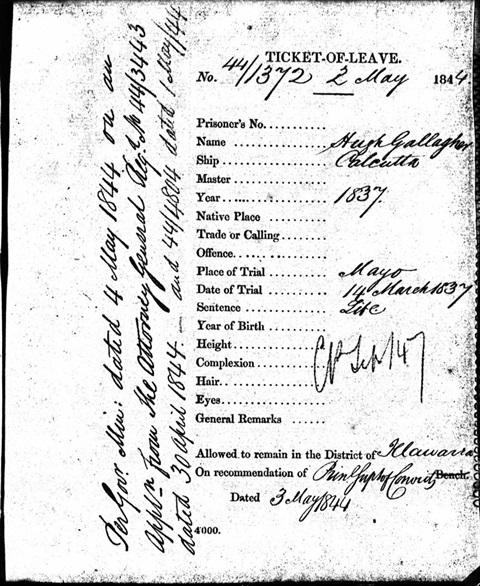GALLAGHER, Hugh

HUGH GALLAGHER
Per CALCUTTA 1837
Hugh Gallagher was a housepainter who, it may cautiously be assumed, probably used the opportunities presented by his trade to fulfil his desire for goods of his liking but not of his ownership. Liking an item is one thing but liking an item and ‘lifting’ it is quite another, and on the 14th March, 1837, the hapless Hugh found himself in the County Mayo Courthouse accused, tried and convicted of Burglary. It is not known what goods were stolen or their value, but it must have been of a reasonable sum to warrant the sentence of:
… for the period of his natural life.
and Transportation to Australia. He was 22 years old.
On arrival on these distant shores Hugh was assigned to Mr. J.R. Plunkett (future Attorney General) of the Keelogue Estate, Illawarra. Despite his rather ignoble past, Hugh proved to be a reliable fellow, and, following the birth of their first son John, applied for, and was granted permission, to marry Sarah Doyle on 4th February,1840. Hugh received his Ticket of Leave on 2nd May, 1844 and a Conditional Pardon on20th December, 1848.
Hugh and Sarah remained in the district raising their increasing family and making a life for themselves. Hugh had proven himself to be a steady and dependable worker. However, tragedy struck this hard-working family on 25th July, 1860, when Hugh, after many days of heavy rainfall, was swept from his horse while crossing the flooded Mullet Creek. He had been on his way to do some contract work on the house of a Mr. Hobbs of Dapto. Although there were no witnesses to the actual event a Mr. Ryan stated that:
‘…[Hugh] was seen … to dismount from his horse and tie a handkerchief round his mouth, and afterwards proceed towards the creek.’
Later that afternoon, word reached Hugh’s family that his horse and saddle had been located but, despite a large number of people searching, no sign of Hugh had been found.
Twelve days later Hugh’s remains were finally located and recovered in a rather unusual way. Hugh’s son stated at the inquest into his father’s death that:
‘On Monday the 6th August, instant, many efforts were made by myself and others to find the body; and about two o’clock in the afternoon, of that day I purchased a new two pound in weight loaf and placed about an ounce of quicksilver in its centre, and then placed the loaf in the water, The loaf floated as nearly as I can guess in the direction of Illawarra Lake about eighty yards, and then ceased floating, and then I saw part of the body.’
He went on to state that:
‘When I first saw the head of the deceased come out of the water I recognized the face as the face of my father.’
Hugh was buried in the old Roman Catholic Cemetery in Wollongong and despite:
‘the bad state of the weather, and the wretched state of the roads, a large number of horsemen and person’s on foot attended as a mark of respect to the deceased.’